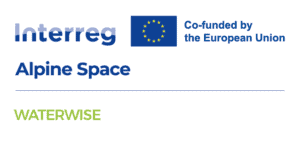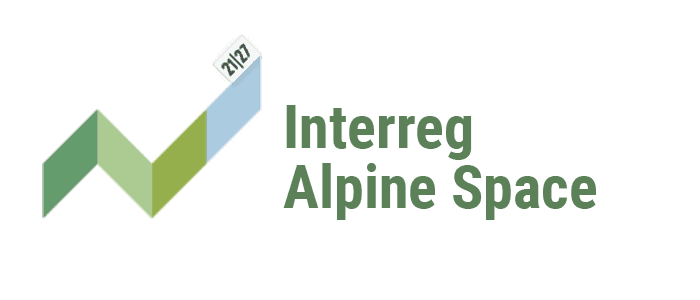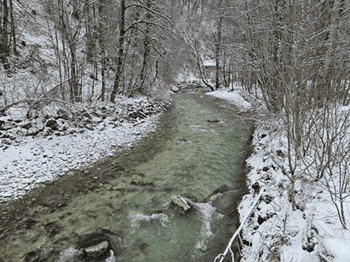
February 21, 2025
Press Release
Melting of glaciers and water management in Garmisch-Partenkirchen: local stakeholders engaged in co-designing future adaptation strategies by a European project
The catchment of River Partnach within the Zugspitze region is identified as one of the pilot areas of Waterwise, a European co-funded project aiming to enhance the resilience of Alpine communities’ water management systems
Higher temperatures in the Alps melt glaciers and permafrost: the northern Schneeferner Glacier is expected to lose its glacier status by 2030
Number of visitors at the Partnachklamm more than doubled in the 2010-2023 timeframe: biodiversity and water resources need to be protected from overtourism
Water is life and this concept is as true as it can be in Alpine and Perialpine regions, where key economic sectors such as industry, agriculture, tourism and energy production heavily depend on local water resources and are vital for the local socioeconomics. Water scarcity though is becoming more and more often an issue that Alpine residents must face due to climate change and its consequences on mountain headwaters. As winter becomes wetter and warmer, and summer dryer and with extreme temperatures at such high altitudes as well, extreme events will increase, and water availability will change more and more for Alpine communities.
In the region of Garmisch-Partenkirchen, the northern Schneeferner and Höllentalferner Glaciers are shrinking at a massive rate: between 2005 and 2018 the Northern Schneeferner lost about half of its remaining ice mass, while the Höllentalferner lost around a third. The southern Schneeferner lost its glacier status in 2022, and at this rate the northern Schneeferner Glacier, too, is expected to lose its glacier status by 2030 (Bavarian Academy of Sciences, 2021).
To achieve a more sustainable and resilient water management, Waterwise, a project co-funded by the European Union through the Interreg – Alpine Space program, is engaging local governance representatives, NGOs, environmental associations and all those who may be affected by this issue, in interactive workshops to co-design future adaptation strategies.
On Wednesday, 12th of February 2025, Garmisch-Partenkirchen hosted the first of said workshops – two more are going to happen in this area, and the project will lead a total of 24 workshops around different Alpine regions – led by members of the Bioeconomy Economics Research Group from the University of Passau, project partner of Waterwise. The workshop focused on identifying local socio-economic and environmental assets and issues, with the final goal of defining a shared hydrological, climatological, ecological, and socio-economic vision. Many local representatives participated in the workshop to share their experiences and needs related to the water resources, and from this discussion the project partners will start developing an innovative online toolbox with useful resources and good practices for local land and water managers and for alpine policy makers.
Different local stakeholders were represented in the workshop, such as: the Bavarian Environmental Office (LfU), the Municipality of Garmisch-Partenkirchen, the Regional Water Management Office, the Schneefernerhaus Research Station, the Bavarian Farmers’ Association – Local Chapter, the Local Fishing Club, the DAV: German Hiker‘s Association (Chapter Munich), the Local Tourism Agency, Bund Naturschutz, the Partnach Gorge Management, and the local chapter of the WWF – World Wildlife Fund.
“The first workshop went well, and we are happy with the important information we gathered from the discussion” says Leon Bögel, who coordinates the Waterwise project activities led by University of Passau. “A big part of the discussion focused on the stability of tourism in the region and how a lot of the tourism is tied to the water resources, both directly and indirectly. For example, tourists ski on the Zugspitze, hike up the Partnach River to visit the Partnach Gorge, but also rely on local agricultural products and clean drinking water. The near future might be safe as the melting of glaciers and permafrost will provide plenty of water to this area, but water levels and availability will decrease significantly further on, after all the ice on the peaks has melted and has not been replaced since rising temperature and lower liquid precipitation will not be enough to do so. This will of course bring many challenges with it and for this our management plans might come in handy”.
Bögel’s mention of the tourism issue reflects the importance that this issue had in the discussion, since the whole region heavily relies on this economic sector: in Garmisch-Partenkirchen around 1,620,000 overnight stays were registered in 2023, and the visitor numbers in the Partnachklamm, a natural monument since 1912 and a national geotope since 2006, more than doubled between 2010 and 2023 (240,000- 490,000), according to the data shared by the Partnachklamm administration itself. In 2023, mayor Elisabeth Koch reported that the local administration was planning to put some restrictions on the number of visitors present at the same time to control water resources and protect the local biodiversity. Moreover, the issue is not strictly local anymore: another river in the region, the Loisach, supplies Munich with water and therefore any sort of change to water quantity and quality here would have repercussions as far as Bavaria’s main city and beyond.
“It seems to me that it is highly relevant to communicate the scientific results to the public in an adequate and good way”, says Dr. Till Rehm, the scientific coordinator of the Schneefernerhaus Research Station, “One important part of the workshop is to bring together a broad range of opinions and perspectives from scientists and from various local stakeholders and I think we achieved this result. It is also vital to adequately communicate scientific findings and to raise the target groups’ awareness through a good communication strategy.”
Around the River Partnach and on the Zugspitze the Waterwise team will collect data from the river network coming from the Northern Schneeferner glacier and these, together with the outcomes from the workshop, will constitute the groundwork for developing co-designed long-term strategies to enhance resilience in the Alps regions, particularly regarding their water resources.
Waterwise expected outcome is an innovative digital toolbox—a set of tools developed through a series of workshops, like the one that just happened in Garmisch-Partenkirchen, held across various regions. This toolbox will serve as a practical guide that can be applied elsewhere to enhance the resilience of Alpine communities, their water resources, and biodiversity. The identified pilot areas where the toolbox will be developed, tested, and validated include, in addition to Schneefernerhaus in Zugspitze, the Contamines Montjoie and Grande Sassière (France), the Jamtal Valley (Austria), Rèchy and Valposchiavo (Switzerland), Sadole (Italy) and the transboundary aquifer of Mount Peca/Petzen (Austria/Slovenia). However, many more areas will serve as testing grounds for the toolbox’s implementation to evaluate its applicability across diverse Alpine environments.
A second workshop is expected to happen in Spring 2026. For any inquiry about the project, one can contact projectwaterwise@gmail.com
Waterwise Press Office
Elisa Leo (Legambiente Piemonte e Valle d’Aosta)
+39 3474066702
e.leo@legambiente.it
Waterwise is co-funded by the European Union through the Interreg – Alpine Space program, involving 12 partners: the University of Neuchâtel (scientific lead), Edmund Mach Foundation (administrative lead, ITA), Réserves naturelles de France (FRA), Legambiente Piemonte e Valle d’Aosta (ITA), EGTC Geopark Karawanken (AUT/SLO), University of Passau (GER), Geological Survey of Slovenia (SLO), Tetraktys (FRA), Karlsruhe University of Applied Science (GER), Alpinarium Galtür Dokumentation Ltd (AUT), Regional Environmental Protection Agency of Lombardy (ARPA, ITA), and the Center for Research in Alpine Environment (CH).



